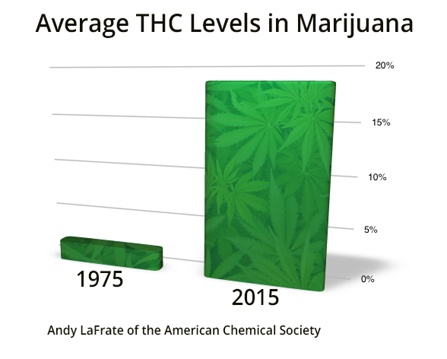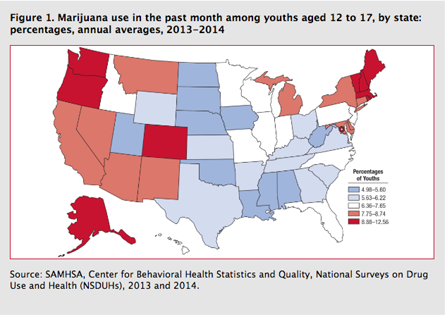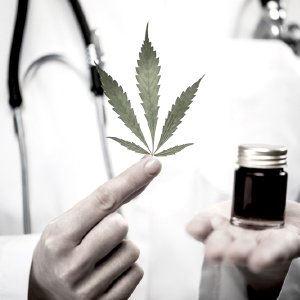The New Millennium of Marijuana: More Potent, More Available, More Profitable
It’s no good thinking of marijuana like it’s 1967 or even 1985 because what we have now bears absolutely no resemblance to what we had then. The current climate of commercialization has driven enormous changes. Essentially, it’s changed the whole activity of producing, distributing and selling marijuana into a vast profitable, corporate enterprise. Investors expect to reap huge profits and of course, this incentive means that the product itself and delivery channels must be made more competitive, profitable and, most importantly, pervasive.
Let’s look at some specific ways marijuana production and use has changed over the years.

POTENCY
Obviously, one major way is that the potency is so much higher. Here’s a comparison made by Andy LaFrate of the American Chemical Society. Of course, marijuana is available at much higher potency levels than 18.7% —that’s just the average. In a marijuana dispensary in states where sales are legal, it’s not hard to find pot with a THC content of 28%. A person buying the concentrated products referred to as hash oil, butter or shatter will get far more potent doses—up to 90% THC. The competition for market share has driven producers to come up with exotic flavors, extremely high potencies and fancy edibles to create strong brands that customers will prefer over others.
AVAILABILITY
With the drug now legal for medical use in more than two dozen states, there is far more availability in American households. In two years, Washington State sales of marijuana topped a billion dollars in recreational marijuana alone, and another billion dollars in medical marijuana. That’s a huge amount of the drug on the market. As with opioids, a huge supply means it will be very easy for people to get their hands on this drug and easier to become addicted as well.
“NORMALIZATION”
This is the word used to describe the consideration that the frequent use of marijuana is a normal activity. When this attitude is held by parents, it rubs off on their children who increasingly think that marijuana use is “no big deal.” The Washington Post wrote an article in 2016 about the way public opinion is shifting toward legalization of use and normalization that you can read here.
USE BY PARENTS IN FRONT OF THEIR CHILDREN
In Washington, one school administrator commented that small children would come to school smelling like marijuana. And an Idaho mother was arrested after blowing smoke into her toddler’s face and then posting a video of this activity on her Facebook page. While this is obviously an extreme case, that story shows how outrageous parenting while high on marijuana can get. There’s little legislation against a parent exposing their children to marijuana unless there is a child abuse or neglect case active.
BIG BUSINESS
According to www.investincannabis.com, there are more than 50,000 cannabis companies and two billion customers for the product. And according to www.thestreet.com, it’s $5.4 billion business, with rapid growth expected. The game now is taking this business mainstream which means acquiring and keeping customers to this addictive substance that causes cognitive decline. For more on cognitive decline, read this article from the Journal of Addiction Medicine.
OPEN CONSUMPTION AND ENDORSEMENT IN MEDIA AND ENTERTAINMENT
With the increased legalization of marijuana, celebrities aren’t shy about stating their preference for this drug. Justin Timberlake, Rhianna, Miley Cyrus, Jennifer Anniston, Woody Harrelson, Kristen Stewart, Sarah Silverman, Lady Gaga and others have come out in favor of it. And innumerable films and television shows have featured its use.
UNWANTED EXPOSURE
Wherever marijuana is legalized for medical or recreational use, the law states that the drug is not to be used publicly. But the truth is that non-users are being exposed to the smell and smoke whether they want to be or not, as are their children. A Washington Post survey found that 70% of people in the D.C. area smell marijuana smoke at least once a month and one in three smell it every day.

The changes we’ve seen so far are likely to snowball into bigger changes as more states pass permissive laws. One has to think about the next generation growing up in an atmosphere increasingly accepting of marijuana use. Will this gradually increase the statistics on young people using this drug? While nationally, the numbers of teen users are not up, Colorado numbers for teen marijuana use are the highest in the country. According to a December 2015 report from the Substance Abuse and Mental Health Services Administration, 12.56% of Colorado youth aged 12 to 17 were current users of marijuana.
If you have children, it’s the wrong time to be complacent.
The most dangerous thing a parent can think is that it won’t be his (or her) child that starts smoking pot, drinking excessively or using drugs that could cause immediate overdose. It’s the right time to be vigilant and to make sure your children have their own understanding on the benefits of staying sober. You can find information from Narconon Ojai on all the major drugs your children are likely to encounter here to help you in the job of keeping your kids sober.
REFERENCE
http://www.cnn.com/2016/10/21/health/colorado-marijuana-potency-above-national-average/
http://www.washingtontimes.com/news/2016/jul/8/marijuana-sales-washington-top-1-billion-report/
http://www.chicagotribune.com/news/nationworld/ct-shatter-super-high-potency-pot-20151223-story.html
https://www.bustle.com/articles/52203-34-celebrities-who-love-pot-dont-care-who-knows-it
http://marijuanastocks.com/content/list-marijuana-stocks/
https://www.ncbi.nlm.nih.gov/pmc/articles/PMC3037578/
http://www.csmonitor.com/USA/2015/1121/Where-marijuana-is-legal-complaints-aired-about-the-smell
http://www.samhsa.gov/data/sites/default/files/report_2121/ShortReport-2121.html


